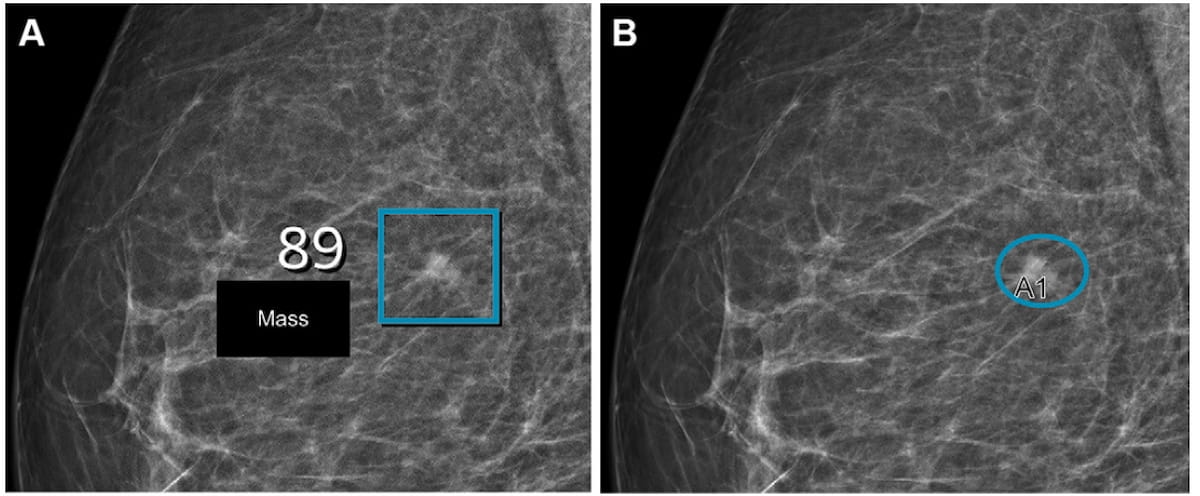Artificial intelligence may have a significant impact in enhancing breast cancer detection in mammography screening and reducing radiologist workloads, according to a large study of nearly 119,000 women in Denmark.
For the retrospective study, recently published in Radiology, researchers compared data from 60,751 women who had mammography screening prior to the implementation of a mammography-based AI system (Transpara version 1.7.1, ScreenPoint Medical) and 58,246 women who had screening after implementation of the AI system. The median age for both cohorts was 58. Double reading by radiologists was utilized prior to the advent of AI and single reading by breast radiologists was utilized for mammography screening deemed to be likely normal by AI, according to the study.
The researchers found the AI system led to decreases of 20.5 percent in the recall rate (2.46 percent vs. 3.09 without AI) and 32 percent in the false-positive rate (1.63 percent with AI vs. 2.39 without AI).
Implementation of the AI system also facilitated increases of 12 percent in the cancer detection rate (CDR) (82 percent vs. 70 percent without AI), 11 percent in the positive predictive value (PPV) (33.6 percent vs. 22.6 percent without AI) and 8.3 percent in the diagnosis of small cancers (44.9 percent vs. 36.6 percent without AI).
“In summary, all screening performance indicators improved except for (the) node-negative rate while the reading workload decreased by 33.5 percent,” wrote lead study author Andreas D. Lauritzen, Ph.D., who is affiliated with the Department of Computer Science at the University of Copenhagen in Demark and the Department of Breast Examinations at Gentofte Hospital in Hellerup, Denmark, and colleagues.
Three Key Takeaways
1. Increased diagnostic accuracy. Implementation of AI in mammography screening improved diagnostic accuracy, as evidenced by an 11% increase in the positive predictive value (PPV) and an 8.3% rise in the detection of small cancers. This suggests that AI can help identify more true positive cases and detect cancers at an earlier stage.
2. Reduced radiologist workload. The AI system significantly reduced the reading workload for radiologists by approximately 33%. By categorizing likely normal screenings, the AI allowed radiologists to focus more on cases that required detailed attention, thus optimizing the screening process.
3. Lower recall and false-positive rates. AI implementation led to a 20.5% decrease in recall rates and a 32% reduction in false-positive rates. Fewer women were called back for additional testing unnecessarily, reducing patient anxiety and healthcare costs associated with follow-up procedures.
Midway through the assessment period for the AI system, the researchers raised the normal screening threshold score for AI exams from < 5 to < 7, but the researchers noted continued decreases in the recall rate (2.26 vs. 2.69) and false positive rate (1.47 vs. 1.82) as well as a significant decrease in the node-negative rate (70.2 percent vs. 85.5 percent).
“In other words, with a higher threshold, fewer women were recalled, and recalls more frequently resulted in a breast cancer diagnosis,” noted Lauritzen and colleagues. “The fact that women with invasive cancer were more frequently determined to have lymph node metastases may be attributable to a generally low number of women with diagnosed lymph node metastases and high variation in diagnoses from month to month.”
(Editor’s note: For related content, see “Study of Mammography AI Software Notes 50 Percent Higher Likelihood of False-Positive Results for Black Women,” “Could a Deep Learning Model for Mammography Improve Prediction of DCIS and Invasive Breast Cancer?” and “Mammography-Based AI Abnormality Scoring May Improve Prediction of Invasive Upgrade of DCIS.”)
Additionally, when the study authors examined the impact of screening interval length, they noted that AI led to a 11 percent increase in CDR for those with 2.67 to three years between screenings, a 32 percent CDR increase for those whose last screening was 2.34 to 2.66 years prior, and a 30 percent CDR increase for women with two to 2.33 years between screenings.
“This indicates that the detection efficiency was preserved or improved with the AI system regardless of the screening interval and that the greater detection efficiency was not solely due to a prolonged screening interval,” pointed out Lauritzen and colleagues.
In regard to study limitations, the authors conceded that the COVID-19 pandemic and a lack of radiologists led to a longer median screening interval with AI screening and possibly higher CDRs as a result. The study authors acknowledged that simultaneous use of AI screening stratification and adjunctive decision support with AI prohibited the assessment of their separate impacts. The researchers also pointed out that reviewing radiologists knew which mammography screenings had been categorized as normal by AI.
